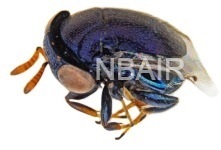Scientific name
Scutellista caerulea (Fonscolombe, 1832)
Taxonomic position
Hymenoptera: Chalcidoidea: Pteromalidae: Eunotinae
Diagnosis
Female: Body robust with metallic bluish-purplish shine, slightly hump-backed. Antenna with scape and flagellum yellow, pedicel dark brown. Head wider than long. Antenna 8 segmented (1151). Scutellum about 2-5 times as long as the mesoscutum, overlapping about half of the metasoma. Fore wing with a subtriangular bare area about in the middle of its hind margin; postmarginal vein distinctly shorter than the stigmal vein. Body length 1.5 to 4 mm.
Male: Similar to female, except smaller in size, scutellum not so enlarged, and antenna 7 segmented (1141) with distinct sensillae.
Image
 Adult - lateral view Adult - lateral view
Distribution
India: Gujarat, Karnataka, Maharashtra and Tamil Nadu.
Biology / Hosts
Primary hosts are from Coccoidea mainly Coccidae, Cerococcidae, Diaspididae and Pseudococcidae- Ceroplastes spp., Coccus viridis, Coccus hesperidum, Cerococcus hibisci, Saissetia nigra, S. coffeae, S. oleae, and many others. For entire host range see Universal Chalcidoidea Database. References
- Boucek, Z. 1988. Australasian Chalcidoidea (Hymenoptera). CAB International, Wallingford, UK. 832 p.
- Fonscolombe, E.L.J.H. Boyer de 1832. Monographia chalciditum galloprovinciae circa aquas degentum. Annales des Sciences Naturelles (1) (Zoologie) 26: 304.
- Narendran, T.C. & Mini, T.V. 2000. A review of the genera of Oriental Eunotinae (Hymenoptera: Pteromalidae). Journal of the Zoological Society of Kerala, 8&9: 15-28.
- Noyes, J.S. 2012. Universal Chalcidoidea Database. World Wide Web electronic publication. http://www.nhm.ac.uk/chalcidoids.
- Sureshan, P.M. 2012. Checklist of Pteromalidae (Insecta: Hymenoptera: Chalcidoidea) of India. ZSI, Western Ghats regional centre, Kozhikode, Kerala. 15pp.
- Viggiani, G. 1997. 2.3.3. Eulophidae, Pteromalidae, Eupelmidae and Signiphoridae, pp. 147-158. In: Soft scale insects - their biology, natural enemies and control (Ben-dov, Y. and Hodgson, C.J., Eds.). Elsevier Science.
|